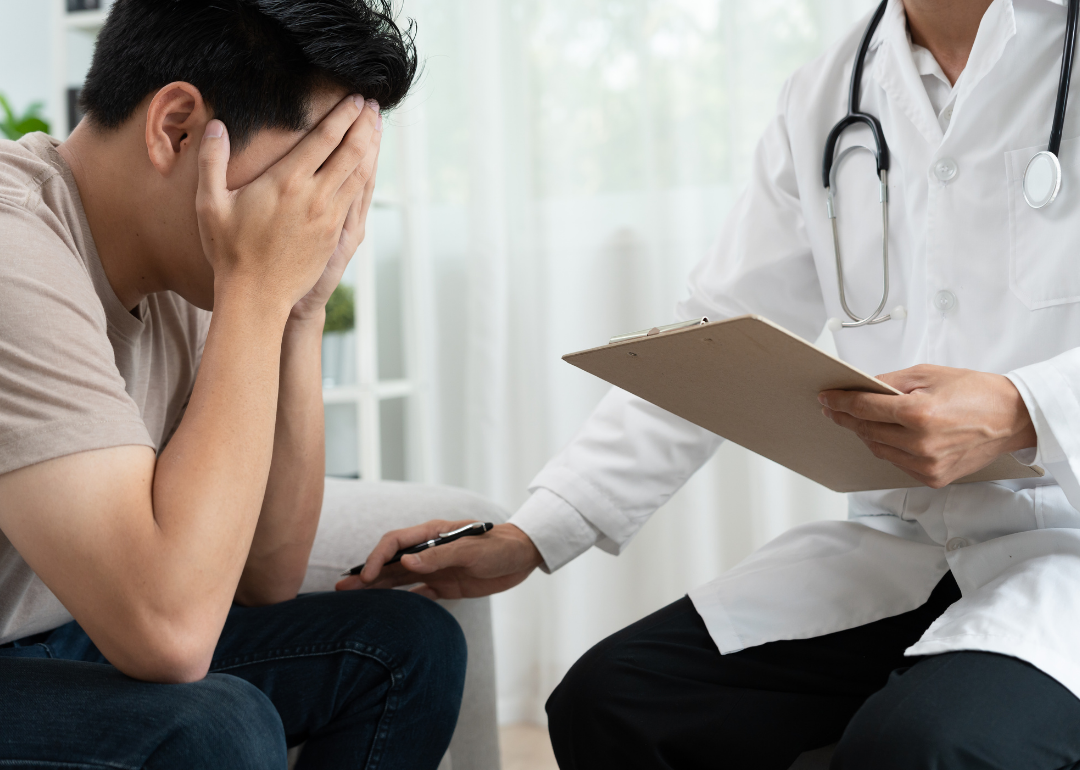
The US is suffering a mental health crisis: Here are the best (and worst) states to find and afford treatment
The US is suffering a mental health crisis: Here are the best (and worst) states to find and afford treatment
Of the 57.8 million U.S. adults living with a mental health condition in 2021, less than half received mental health services in the past year, according to the National Institute of Mental Health. While mental health care access in the United States needs improving across the board, some states are better resourced than others.
To explore the best and worst states for mental health care, MoneyGeek ranked states on their mental health care quality using data from the National Substance Use and Mental Health Services Survey, U.S. Census Bureau, Mental Health America, and more. We considered access to care, costs, insurance rates for those with mental health conditions, and prevalence of anxiety and depression, among other factors. More details on our analysis are included in our methodology below.
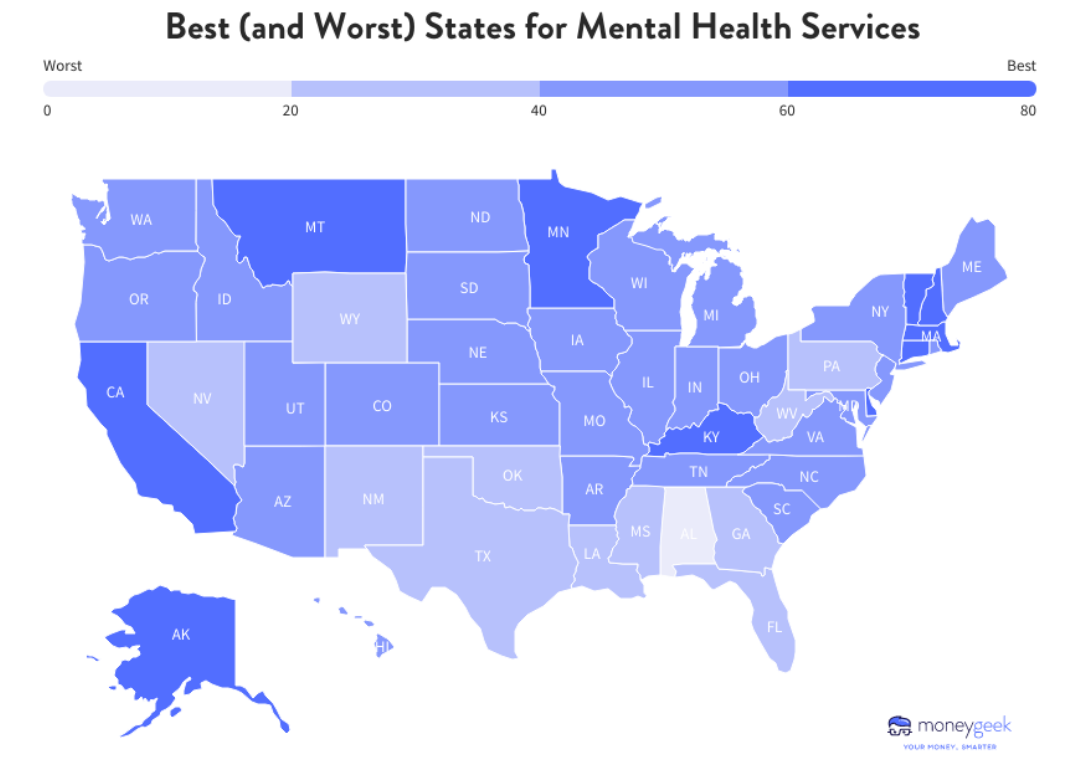
Key findings
- Availability of mental health providers varies dramatically across the country: Between the state with the most mental health providers per capita (Vermont) and the fewest (Mississippi), there is a nearly tenfold difference. The number of mental health facilities per 100,000 residents is similarly split — the best state (Maine) has more than nine facilities per 100,000 people while the worst state (Texas) has less than one.
- The number of mental health facilities is declining nationwide: Over two years, the number of mental health treatment facilities has declined by an average of nearly 30%. The state with the steepest decline (Hawaii) lost more than half (61%) of its mental health facilities while the state with the lowest decrease (Missouri) lost just 7%. Hawaii had just one facility per 100,000 residents and Missouri had just three, putting both in the bottom third of states.
- Costs are a significant barrier to mental health treatment: In 35 states and the District of Columbia, at least 50% of adults report not getting mental health care because of the cost. Average out-of-pocket costs for people living with mental health conditions are nearly $1,500 nationwide. At the high end, people in Mississippi, Oklahoma, and Kansas spend more than $1,700 per year out-of-pocket.
- More people are insured in the Northeast: Four New England states and New York are among the 10 states where people with mental health conditions are least likely to be uninsured. Only 6% of residents with mental health conditions in these top 10 states are uninsured; the average in the other 40 states and Washington, D.C., is more than double that at 12%.
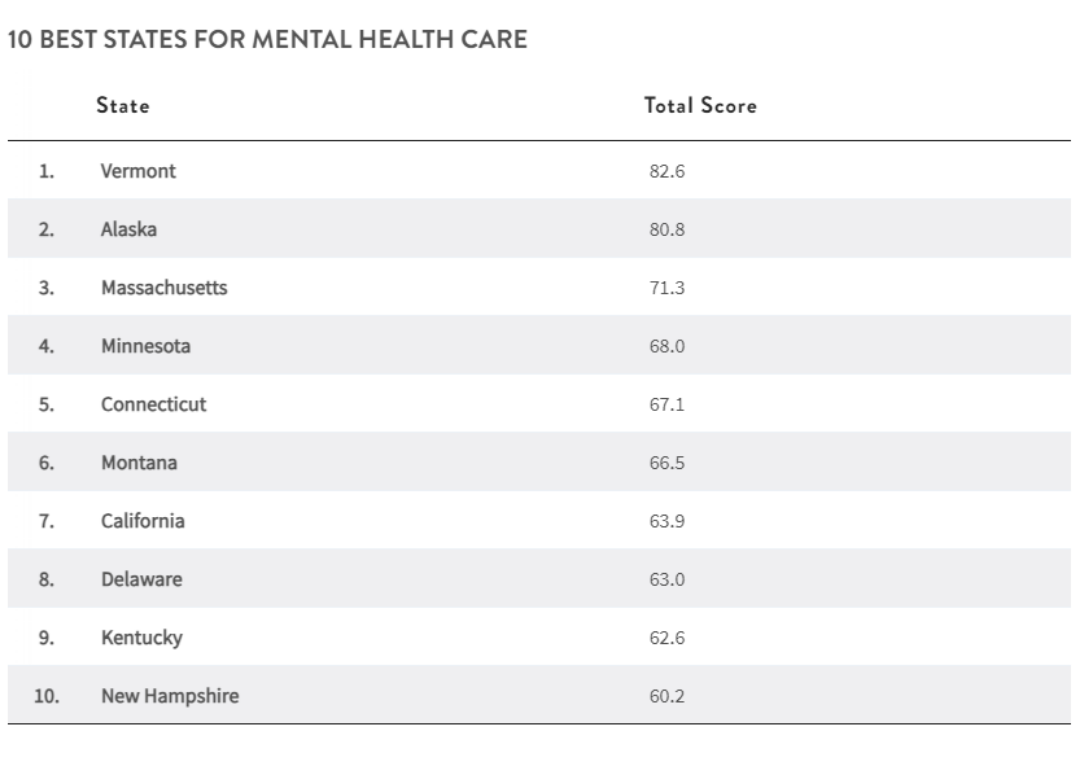
Top states for mental health care share key characteristics
Three New England states — Vermont (No.1), Massachusetts (No.3) and Connecticut (No.5) — appear in the top five best states for mental health services. The other top states are farther west on the map, with Alaska ranking No.3 and Minnesota, No.4. These states all have relatively high numbers of mental health providers, treatment facilities, and bed capacity.
The top states do not necessarily have the lowest medical costs for people with mental illness, but they tend to have fewer adults reporting that cost is a barrier to seeking mental health care. Nationwide, the average rate of adults citing cost as the obstacle to mental health care is 46%; two out of the top five states — Massachusetts (43%) and Vermont (43%) are better than the national average.
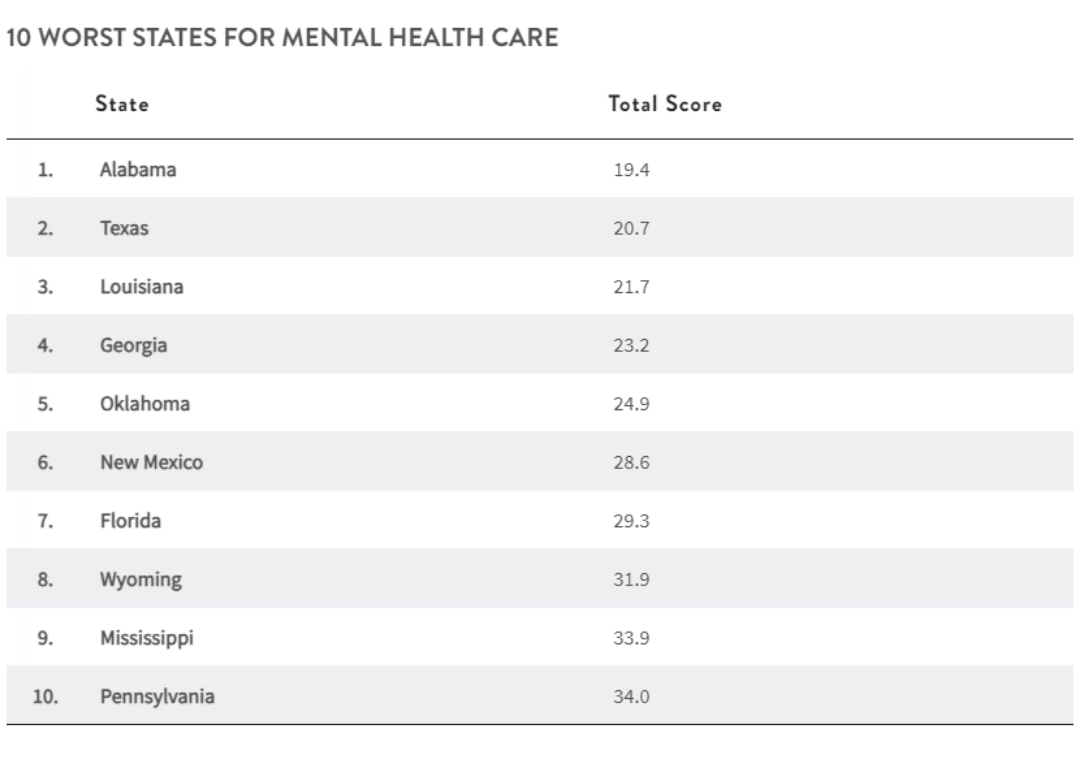
States in the South and Southwest rank worst for mental health care
The five worst states for mental health services are concentrated in the South and Southwest. These states have many fewer mental health treatment facilities per 100,000 residents than average, with Texas having the lowest number of any state. These states also have lower than average capacity in treatment facilities and fewer than average mental health providers overall. Louisiana had a nearly 50% decline in available mental health treatment facilities from 2019 to 2021, the fourth largest decline of any state.
Costs serve as a barrier for more than half the adults with mental health conditions in the five worst states for mental health care. In Texas and Alabama, that figure topped 60%. These states also have relatively high uninsured rates among people living with mental illness. In Texas, 21% of these individuals have no health insurance, nearly double the national average of 11%.
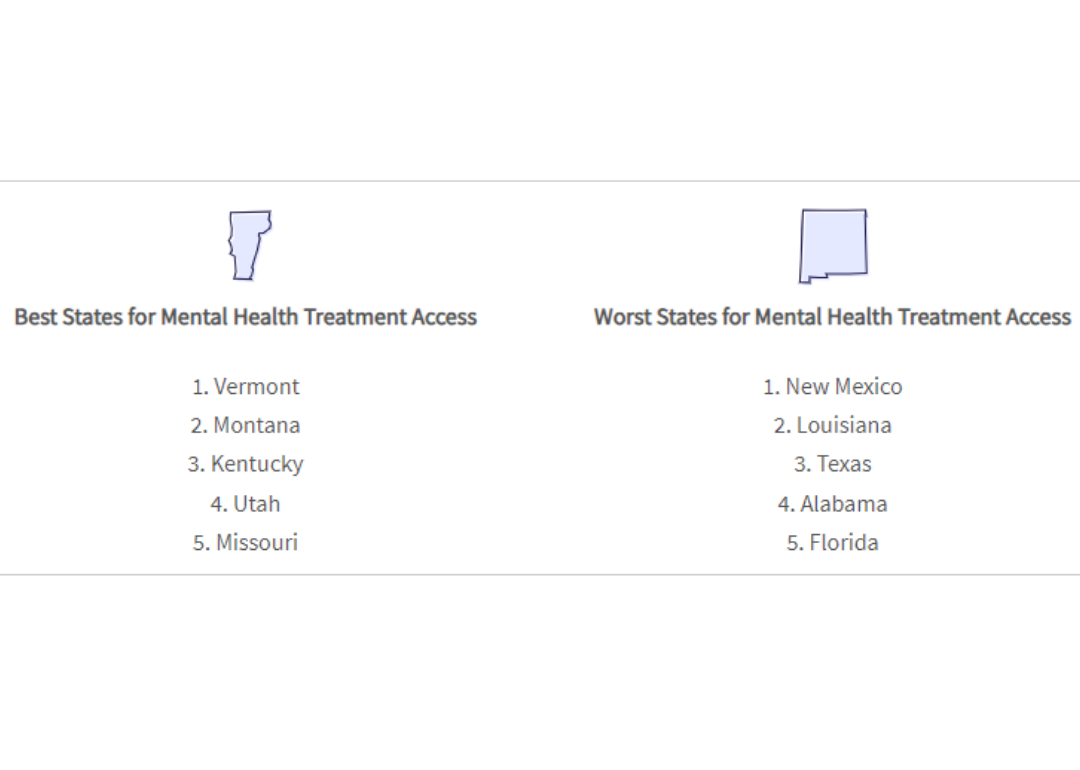
Mental health care is a mixed bag: Many states that excel in one domain lag in others
Every state has its strengths and weaknesses when it comes to mental health care. Some have plenty of facilities but fall short on experts. While some ensure affordable care, others grapple with a high count of residents facing mental health challenges.
Access to facilities and providers may pose different challenges
Access to mental health care depends on the availability of both mental health providers and facilities. Unfortunately, these measures often aren't correlated with each other. Only Montana, ranked No.6 overall, has among the most mental health facilities, facility beds, and mental health care providers generally. Vermont, the No.1 state overall, is also among the top ten states for both the number of facilities for the population and the number of providers.
Arizona (No. 18), Nebraska (No. 35), Wyoming (No. 44), Utah (No. 21), West Virginia (No. 41) and Maine (No. 12) are all among the best states for the number of facilities per 100,000 people and the number of beds in those facilities, but fall short when it comes to the number of available mental health providers. All of these states — with the exception of Arizona and Utah — have relatively small populations, each with fewer than two million residents.
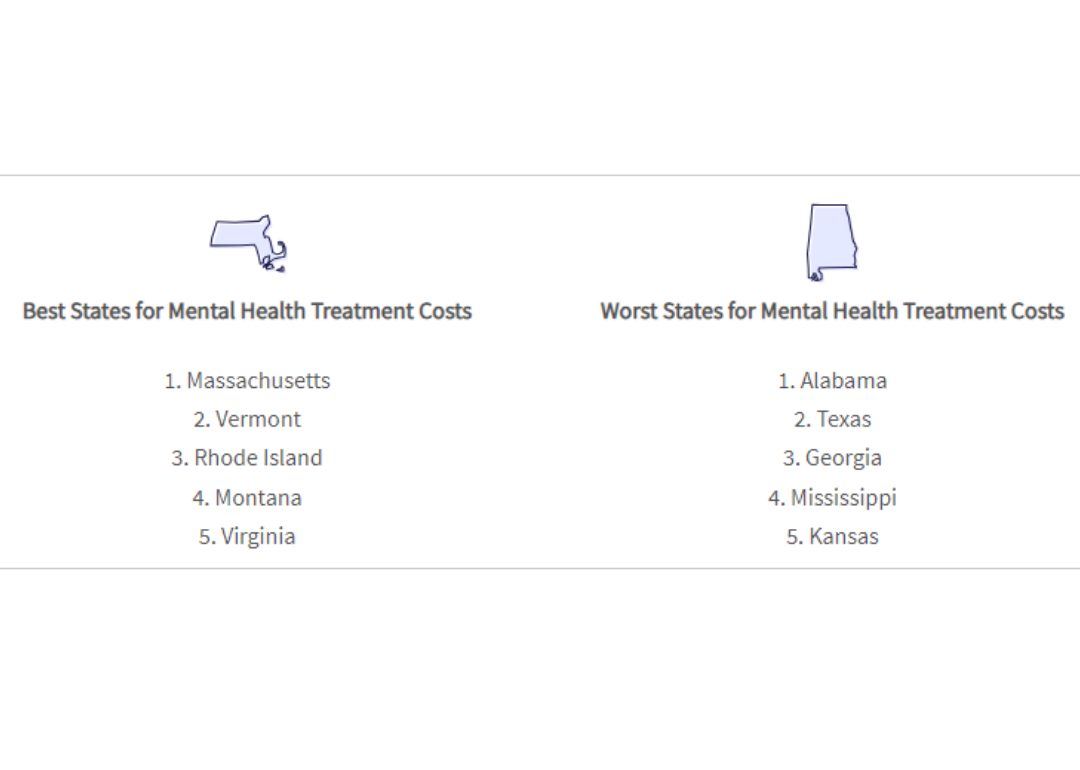
Both uninsured rates and overall cost contribute to affordability of care
When it comes to cost-related measures in mental health care, a few states stand out across the board. Massachusetts and Vermont, which rank in the top five states overall, have among the lowest out-of-pocket costs, the fewest people reporting costs as a barrier to care, and the lowest uninsured rates.
On the flip side, Alabama and Texas are the lowest-ranked states overall and also among the worst performers on cost measures. Both have 62% of people reporting costs as a barrier to mental health care and average out-of-pocket expenses over $1,600 per year. At the same time, these states have relatively high rates of uninsured individuals living with mental health conditions, 21% in Texas and 18% in Alabama; the national average is 11%.
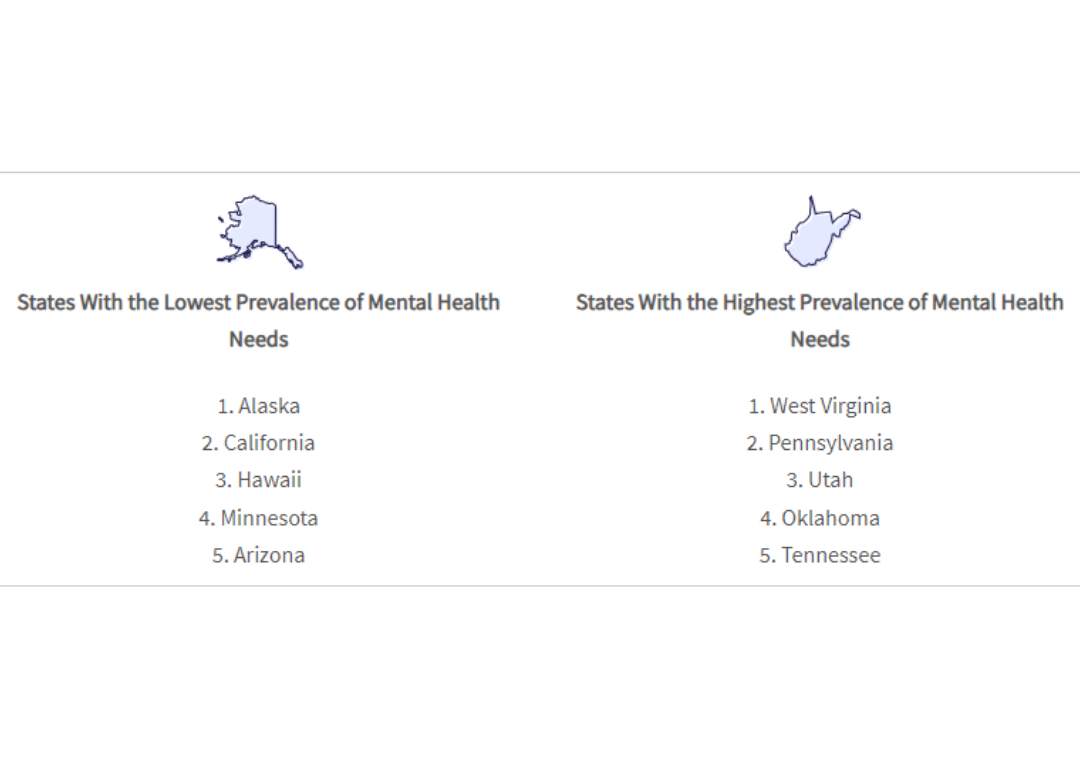
Anxiety and depression prevalence varies across states
To understand the prevalence of mental health conditions in each state, MoneyGeek utilized data from the Census Household Pulse about the percentage of residents experiencing symptoms of anxiety or depression over a two-week period, as well as examining the average search volume for mental health services in the state. Using these three metrics, the states were scored and ranked by the lowest and highest prevalence of mental health care concerns.
States in the South have the highest rates of depression and the most Google searches for mental health care. Specifically, Mississippi, Louisiana, and Alabama are all among the top ten states with the highest rates of depression and the most Google searches for mental health services.
The list of states with the highest rates of anxiety looks different. Washington, D.C., reported the highest rates of anxiety (28%), compared to the national average of 22%. States like Iowa, Utah, Washington, Oregon, and Missouri — otherwise in the middle of the pack overall — have some of the highest rates of anxiety in the U.S., but not depression. New Mexico has the distinction of being the only state on all three top ten lists for states with the most anxiety, depression, and Google searches for care.
Securing affordable, high-quality mental health care
Working with a qualified mental health provider is often a crucial part of addressing mental health difficulties. However, as the findings in this analysis make abundantly clear, securing affordable care often isn't easy. Access and cost are just two of many barriers to treatment in the current mental health care system: if you've had trouble securing a provider, you're not alone.
Learning how to navigate insurance for mental health care can be a helpful place to start when looking for a provider, whether you're planning on seeking care through a health insurance plan or as a private pay client. The following additional resources may also be useful:
- The impact of debt on mental health
- Are pre-existing mental health conditions covered by health insurance?
- Sample health insurance quotes
If you need immediate mental health support, are thinking about suicide or are worried about a friend or loved one, call or text the Suicide & Crisis Lifeline at 988 or contact the Crisis Text Line by texting HOME to 741741. Both of these helplines are available to everyone in the U.S. and are free and confidential.
Methodology
To explore and rank the best states for mental health services by state, MoneyGeek considered 10 metrics across three categories: access and quality, cost, and prevalence. Each state was ranked in every metric, which was then used to calculate a final ranking score through a weighted average for each category. Each metric was given a full weight except for the number of mental health treatment facilities per 100,000 people and number of beds available in mental health facilities per 100,000 people — both of these were half-weighted. The state with the highest final ranking score ranks as the best state for mental health services.
Access and Quality
- Number of mental health treatment facilities per 100,000 people. Data comes from the Department of Health and Human Services's 2021 National Mental Health Services Survey and the Census Bureau's 2021 one-year American Community Survey.
- Number of beds available in mental health facilities per 100,000 people. Data comes from the Department of Health and Human Services's 2021 National Mental Health Services Survey and the Census Bureau's 2021 one-year American Community Survey.
- Mental health providers per 100,000 people. Data comes from the 2021 Census ACS PUMS Microdata and the Census Bureau's 2021 one-year American Community Survey.
- Two-year percent change in mental health treatment facilities. Data comes from the Department of Health and Human Services's National Mental Health Services Survey and is for 2019 and 2021.
A higher Access Score indicates better access to mental health care.
Cost
- Annual average out-of-pocket spending for adults with a mental Illness. This uses the national average out-of-pocket spending cost for privately-insured enrollees treated for depression and/or anxiety and adjusts for cost of living. Data comes from the Peterson-KFF Health System Tracker and the Missouri Economic Research and Information Center.
- Adults who reported not receiving mental health treatment because of cost. Data comes from Mental Health America's 2023 State of Mental Health in America.
- Percentage of adults with any mental illness who are uninsured. Data comes from Mental Health America's 2023 State of Mental Health in America report.
A higher Cost Score indicates lower mental health care costs.
Prevalence
- Percent of residents experiencing symptoms of anxiety experienced in the past two weeks. Data comes from the Census Household Pulse and is for the time period between June 28, 2023 and July 10, 2023.
- Percent of residents experiencing symptoms of depression experienced in the past two weeks. Data comes from the Census Household Pulse and is for the time period between June 28, 2023 and July 10, 2023.
- Average search volume for mental health services. This is Google Trends search volume for the following keywords: "psychologist near me," "psychiatrist near me," "counseling near me" and "therapy near me." Data covers the 12-month period from August 4, 2022 to August 4, 2023.
A higher Prevalence Score indicates lower prevalence of mental health conditions.
This story was produced by MoneyGeek and reviewed and distributed by Stacker Media.



